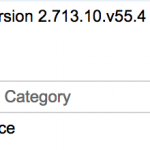The subject Internet of Things (IoT) is intriguing to me, both from a technical and personal point-of-view. IoT to me is where all current cloud initiatives and network virtualization innovations come together, complemented with new technologies. Today, we are realizing highly scalable cloud platforms that are secure and easy to manage as they serve our workloads and store data. Building these scalable cloud platforms and seeing traction on cloud native applications is another push to support IoT innovations. It is fun to see that we are moving towards adopting cloud technologies, but are already on the verge of entering new technology rapids.
Innovation is moving at a scarily fast pace. – Bill Gates
Looking at IoT and its applications, one will quickly notice that the possibilities are immense! The future will be data driven. All our devices, be it a mobile phone, smartwatch, car, plane or refrigerator, will gather data that will lead to more insights on how we as human beings operate and consume. That will lead to services being specifically tailored per individual. And what about enterprises and industrial components? Imagine what can be done in every industry vertical. We can only try to understand the opportunities.
Data in Edge
We may be somewhat dismissive about every device being connected to the ‘internet’, but IoT is already happening. Think about ordering sushi or fast food in selected restaurants where the order is entered using a tablet or similar device. Or what about a hospital where patient data is gathered by sensors and is accessible on mobile devices for the nurses. Think about a car that is collecting data about the driver and his driving characteristics, or the data that is generated by the vehicle itself. Each sensor in a device will collect data, we are talking about a lot of data mining here… Think Gigabytes of data from a single car drive or Terabytes per plane per flight.
The future includes Brontobytes and Geobytes – Michael Dell
That raises the question; is all this data consumable? How are we going to collect all that data? How do we process, analyze and store that data? At first looks, you may think that all the data is ingested in a central cloud environment. But that is not efficient. Because we are talking about a prodigious amount of data it only seems logical to process, analyse and even compress the data locally before sending the important catches of data over to a centralized platform.
Local data processing will require local compute and storage resources, also referred to as edge computing. So even though we have cloud computing as a tool execute data processing, it seems inevitable that data will use local compute and storage power on edge devices. It will be interesting to track the application and development of efficient edge compute solutions (like nano-servers, further usage of Field-programmable Gate Array (FPGA) chipsets, etc.) in the near future.
Moving to edge computing is interesting because today we are in the process of centralizing IT in cloud solutions while IoT innovations will lead to decentral systems, although accompanied by central systems. They will supplement each other.
NFV
A very important factor for IoT and edge devices will be the telecom providers and as they will provide 5G services. The rollout of 5G is a key driver for IoT as it allows for a very low and consistent latency while increasing the bandwidth which is required to support connectivity to the edge devices. This will be a necessity as we will be transferring a lot of data from a massive amount of IoT devices to a centralized cloud platform. The ability to create highly scalable and performant 5G platforms will depend strongly on Network Functions Virtualization (NFV).
Telco operators are working hard on moving from a monolithic telco workload landscape to fully virtualized platforms. VMware helps to thrive NFV adoption with vCloud for NFV that includes vSphere, NSX and related components. It is very important to squeeze every bit out of hardware and the ESXi / VM layer to realize consolidation ratios and lower costs while building a consistent performant fundament for NFV. That was one of the key reasons for us (Frank and myself) to write the Host Deep Dive book.
In the process of working towards NFV and IoT, are we finally forced to adopt IPv6? I would say ‘yes’! IPv4 will simply not cut it anymore, as we all said well before 2010.
To conclude…
We have enough challenges to deal with, but we can already see new solutions being developed to deal with security and manageability of IoT and edge components. Cloud (native) platforms are gaining traction and so is NFV.
I am still trying to wrap my head around the endless possibilities and try to understand the impact of the IoT and edge wave, powered by powerful NFV and cloud platforms. Very exciting times ahead!! We are only scratching the surface of what can be done with IT.



Niel – can we connect? I have a working group of leading thinkers on IoT, Blockchain, and Machine Learning applications for the Consumer.
Yes we can!